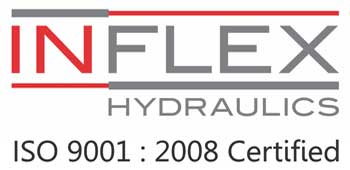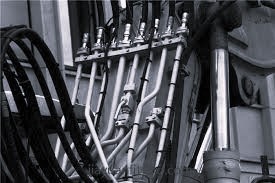SAE Flange Connectors: Types, Materials, and Applications
Are you looking for a versatile and reliable solution for connecting hydraulic systems? Look no further than SAE flange connectors! These connectors, available in various types and made from different materials, offer numerous advantages.
In this article, we will explore the types, materials, and applications of SAE flanges in industries such as construction, agriculture, and manufacturing.
Whether you need to connect pipes, hoses, or other hydraulic components, SAE flanges are the go-to choice for a secure and efficient connection.
Key Takeaways
- SAE flange connectors come in different types, such as the SAE 3000 PSI and SAE 6000 PSI for varying pressure requirements, as well as the SAE split flange connector for easy installation and removal.
- Common materials used for SAE flanges include steel (carbon steel for strength and durability, stainless steel for corrosion resistance) and aluminum (aluminum alloy for lightweight and corrosion resistance).
- SAE flanges provide secure and leak-free connections, making them suitable for high-pressure and high-flow rate applications. They are also easy to install and disassemble for maintenance or repairs.
- SAE flanges find applications in various industries, including hydraulic systems, automotive, construction, agriculture, manufacturing, and more. They are used in heavy machinery, agricultural equipment, hydraulic power units, robotics, material handling equipment, and injection molding machines, among others.
Types of SAE Flange Connectors
There are several different types of SAE flange connectors that you can choose from. These connectors are widely used in hydraulic systems to provide a secure and leak-free connection between components.
One common type is the SAE 3000 PSI flange connector, which is designed for medium-pressure applications. It has four bolts and a sealing ring to ensure a tight connection.
Another type is the SAE 6000 PSI flange connector, which is used for high-pressure applications. It has six bolts and a metal-to-metal seal for added strength and reliability.
Additionally, there are SAE split flange connectors, which allow for easy installation and removal without disconnecting the entire system.
Each type of SAE flange connector has its own advantages and is selected based on the specific requirements of the hydraulic system.
Common Materials Used for SAE Flange Connectors
To ensure durability and reliability, SAE flanges are commonly made from a variety of materials. These materials are carefully selected based on their specific properties and suitability for different applications.
Here are the common materials used for SAE flanges:
- Steel:
- Carbon steel: Known for its strength and durability, carbon steel is a popular choice for SAE flanges. It can withstand high pressures and temperatures, making it suitable for demanding applications.
- Stainless steel: With its excellent corrosion resistance, stainless steel is often used in environments where exposure to moisture or chemicals is a concern. It provides long-lasting performance and is ideal for applications in industries such as marine and food processing.
- Aluminum:
- Aluminum alloy: Lightweight and corrosion-resistant, aluminum alloy is commonly used when weight reduction is a priority. It’s suitable for applications where high strength isn’t essential but good conductivity and corrosion resistance are required.
Advantages of SAE Flange Connectors
One of the key advantages of SAE flange connectors is their ability to provide a secure and leak-free connection. These connectors are designed with precision and accuracy, ensuring that they fit together tightly and prevent any fluid leakage.
The flange design allows for a strong and reliable connection, making it ideal for applications that require high pressure and high flow rates. Additionally, SAE flanges are easy to install and disassemble, saving time and effort during maintenance or repairs.
Their robust construction and durability make them suitable for use in various industries, including hydraulic systems, automotive applications, and industrial machinery.
With their ability to offer a reliable and leak-free connection, SAE flanges provide peace of mind and optimal performance in fluid transfer systems.
Factors to Consider When Choosing SAE Flange Connectors
Consideration of key factors is essential when choosing SAE flanges. To help you make an informed decision, here are some important factors to consider:
- Application requirements:
- Understand the specific needs of your application, such as pressure rating, temperature range, and fluid compatibility.
- Pressure rating: Ensure that the connector can withstand the maximum pressure it will be subjected to.
- Temperature range: Consider the operating temperature range and choose a connector material that can handle it.
- Fluid compatibility: Verify that the connector material is compatible with the fluid being conveyed.
- Connector size and type: Determine the required size and type of SAE flange connector based on the dimensions and specifications of your system.
Applications of SAE Flange Connectors in the Construction Industry
SAE flange connectors find extensive use in the construction industry for various applications. These connectors play a crucial role in ensuring the safe and efficient operation of hydraulic systems in construction machinery.
One of the primary applications of SAE flanges in the construction industry is in hydraulic systems of heavy machinery such as excavators, cranes, and loaders. These connectors provide a secure and leak-free connection between hydraulic components, enabling smooth and reliable operation of the machinery.
Additionally, SAE flanges are used in hydraulic systems for concrete pumps, allowing for the precise and controlled delivery of concrete to construction sites.
The robust design and high-pressure capabilities of SAE flange connectors make them suitable for the demanding conditions encountered in the construction industry, ensuring the reliability and longevity of hydraulic systems.
Applications of SAE Flange Connectors in the Agriculture Industry
If you frequently work in the agriculture industry, you’ll find that SAE flanges have numerous applications in various agricultural machinery. These connectors play a crucial role in ensuring the efficient operation of equipment and improving productivity.
Here are some key applications of SAE flanges in the agriculture industry:
- Hydraulic Systems:
- SAE flanges are commonly used in hydraulic systems of agricultural machinery such as tractors, combines, and harvesters.
- They provide a secure and leak-free connection between hydraulic components, such as pumps, valves, and cylinders, ensuring smooth operation and precise control.
- Irrigation Systems:
- SAE flange connectors are utilized in irrigation systems to connect pipes, valves, and pumps.
- They enable the easy installation and maintenance of irrigation equipment, ensuring reliable water distribution and efficient crop irrigation.
Applications of SAE Flange Connectors in the Manufacturing Industry
SAE flanges find extensive use in the manufacturing industry to facilitate the connection of hydraulic components and ensure the smooth operation of machinery. These connectors provide a secure and leak-free connection, making them ideal for various applications in manufacturing.
| Applications of SAE Flange Connectors in the Manufacturing Industry | |
|---|---|
| Hydraulic Power Units | Machine Tools |
| Robotics | Material Handling Equipment |
| Injection Molding | Presses |
SAE flange connectors are commonly used in hydraulic power units, providing a reliable connection between the hydraulic pump and the motor. They are also employed in machine tools, ensuring efficient transmission of hydraulic power for tasks such as cutting, drilling, and shaping. In the manufacturing industry, SAE flanges play a crucial role in robotics, allowing precise control of movements. Additionally, these connectors are used in material handling equipment, enabling smooth and safe operation. They are also utilized in injection molding machines and presses, ensuring the precise delivery of hydraulic power for accurate and efficient manufacturing processes.
Frequently Asked Questions
Are SAE Flange Connectors Suitable for High-Pressure Applications?
Yes, SAE flange connectors are suitable for high-pressure applications. They are designed to handle high pressures and provide a secure and leak-free connection, making them an ideal choice for such applications.
What Is the Maximum Temperature Range That SAE Flange Connectors Can Withstand?
SAE flanges can withstand a maximum temperature range that depends on the specific material used. It is crucial to consult the manufacturer’s specifications to ensure they are suitable for your application’s temperature requirements.
Can SAE Flange Connectors Be Used in Corrosive Environments?
Yes, SAE flanges can be used in corrosive environments. They are designed to withstand the effects of corrosion and are made from materials that offer excellent resistance to chemical reactions.
Are There Any Specific Safety Precautions to Consider When Using SAE Flange Connectors?
When using SAE flanges, it is important to take specific safety precautions into account. These precautions ensure the proper functioning and minimize risks associated with the connectors.
Can SAE Flange Connectors Be Customized or Modified to Fit Specific Equipment or Systems?
Yes, you can customize or modify SAE flanges to fit specific equipment or systems. This allows for a more precise and efficient connection, ensuring optimal performance and compatibility in your application.
Conclusion
SAE flange connectors are essential components in various industries, including construction, agriculture, and manufacturing. They provide a reliable and efficient way to connect hydraulic systems, ensuring seamless operation and minimizing the risk of leaks.
With a wide range of types and materials available, choosing the right SAE flange connector requires careful consideration of factors such as pressure rating and compatibility with the hydraulic system.
By selecting the appropriate connector, industries can optimize their operations and enhance productivity.
Here is an easy guide to SAE Single Part Flanges.
How to identify Fluid Ports and Connectors
All you wanted to know about SAE flanges… Click here!
Here is a comprehensive guide about Hydraulic Flanges and Components

